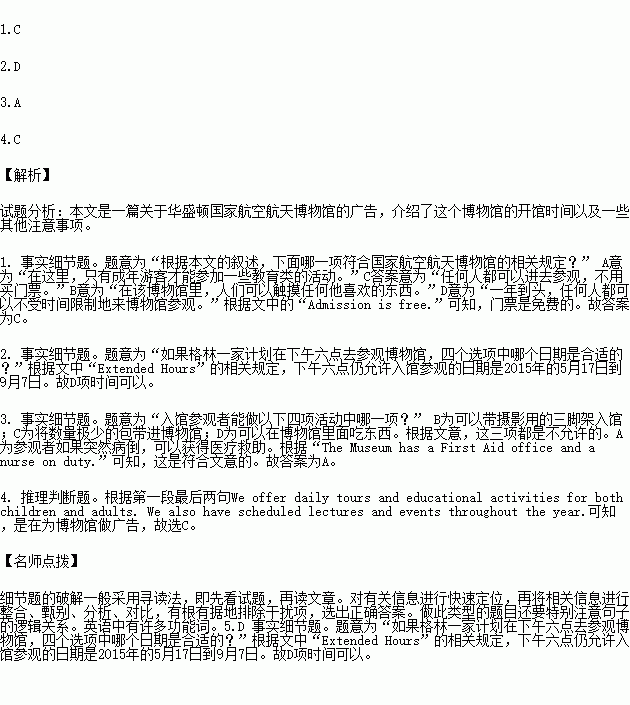题目内容
The National Air and Space Museum in Washington, DC has thousands of objects on display, including the 1903 Wright Flyer, Charles Lindbergh’s Spirit of St. Louis, the Apollo 11 Command Module Columbia, and a lunar rock you can touch. In addition to our exhibition gallery, you may want to visit the Albert Einstein Planetarium, Lockheed Martin IMAX Theater, and the Public Observatory on the east end. There are many things to do at the Museum in DC. We offer daily tours and educational activities for both children and adults. We also have scheduled lectures and events throughout the year.
Hours and Admission: Open every day except December 25. Admission is free.
Regular Hours: 10:00 am to 5:30 pm
Extended Hours: 10:00 am to 7:30pm
December 26—30, 2014 March 30—April 20, 2015
Friday and Saturdays, April 24—May 16, 2015 May 17—September 7, 2015
Visiting Tips: Limit the number of bags: All visitors are screened through metal detector upon entry. The fewer items you bring inside the Museum, the faster your entry. Before you visit, please review the list of prohibited items, which include pocket knives and tripods(三脚架). Visitors carrying prohibited items will not be allowed inside the Museum, so please leave them at home or in your car.
No Food or Drink: Only bottled water is permitted in the Museum. You may only consume food and other drinks in the Food and Drink Court, not in the Museum. Groups who bring food are encouraged to picnic on the National Hall.
Please Take Photos: You are welcome to take photos for personal use. However, tripods and monopods(单脚架) are not permitted without approval.
First Aid: The Museum has a First Aid office and a nurse on duty. Please contact the nearest security officer or the Welcome Center for assistance.
Visit the Welcome Center: At our Welcome Center in the South Lobby, staff and volunteers can answer any questions you have during your visit.
Open: 10:00 am to 5:30 Phone: 202-666-2212
E-mail: NASM-visitorservice@si.edu
1.According to the passage, the National Air and Space Museum is a place ________.
A. where only adults can take part in some educational activities
B. where one can touch anything he likes
C. everyone can pay a visit to without buying tickets
D. everyone can visit everyday all the year round
2.A visitor can visit the Museum at 6:00 pm, on ________.
A. December 24, 2014(Wednesday)
B. March 1, 2015(Sunday)
C. September 15, 2015(Tuesday)
D. July 6, 2015(Monday)
3.A visitor to the Museum can ________.
A. get some medical treatment if he suddenly falls ill
B. take photos with tripods for personal use
C. bring fewer bags to go through metal detectors
D. eat and drink in the Museum or in the Food Court
4.The passage probably appears in ______.
A. a lecture
B. a history textbook
C. an advertisement
D. a science report
 开心蛙状元测试卷系列答案
开心蛙状元测试卷系列答案

